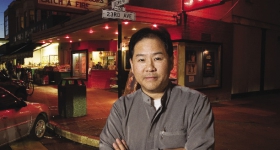It's January, but San Francisco’s winter chill can’t be felt in the steamy confines of El Nino Training Center. Echoing within the walls of this Bayview-Hunters Point gym — which is owned and operated by Strikeforce Mixed Martial Arts (MMA) fighter Gilbert Melendez — are the sounds of grunting, limbs slapping upon mats and the whirring of James Z. Feng’s video camera focused on a dozen fighters preparing to compete. Some of these young men and women have relocated to the San Francisco Bay Area just to undergo training in MMA, a full-contact combat sport incorporating martial arts styles such as boxing, wrestling and judo.
Feng’s crew is nearly done filming the independently produced documentary Fight Life. The film’s tagline -- “All pain. No glory.” -- sums up both the behind-the-scenes rigor of MMA, one of the nation’s fastest-growing sports, and the crew’s own experiences as indie filmmakers seeking resourceful ways to stretch a chronically limited budget.
The first MMA matches in 1993, subsumed by the promotional company Ultimate Fighting Championship, were violent and gimmicky spin-offs of Brazilian jujitsu. Since then, fighting styles have been streamlined and guidelines implemented. As the sport has gained legitimacy, a profitable industry has formed around the octagonal fighting ring.
Feng wanted to spotlight fighters’ personal stories and dispel misconceptions about MMA. In previous films about MMA, according to Feng, “negativity has really been the focal point” such that the sport is portrayed as too violent or likened to “human cockfighting.” In contrast, Feng says, “my goal is to show that [MMA] is a real sport” by presenting stories that reveal MMA fighters as “people you can relate to.” Fight Life strips away MMA’s idealized facade, which is an artifact of big-money endorsement deals, and springboards to Hollywood roles for fighters such as Quinton “Rampage” Jackson’s turn in the film adaptation of The A-Team (2010). Instead, the film looks at the hardships of training, life on the road, the modest prize money earned by newer fighters, tolls taken on personal relationships and health risks faced by uninsured competitors.
This was a preview of The New Legacy Issue. To read the full story, subscribe to Hyphen or pick up a copy at a newsstand near you.










Comments
Hello Anonymous,
The historical reference to UFC was paraphrased from this Time magazine article: http://www.time.com/time/magazine/article/0,9171,1106294,00.html.
The debunking of negative notions does not focus on any MMA organization, but rather on the personal lives of the fighters.
Sylvie
Hi Le Sheng,
As an independently produced film, the release date is still up in the air but we will be sure to update the article when we hear from the producers.